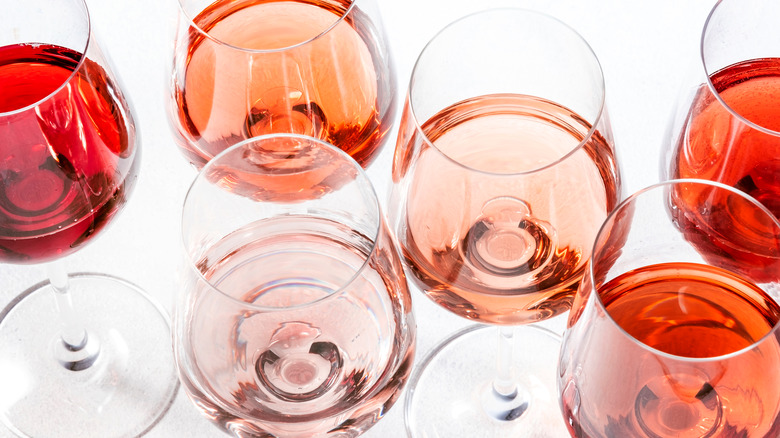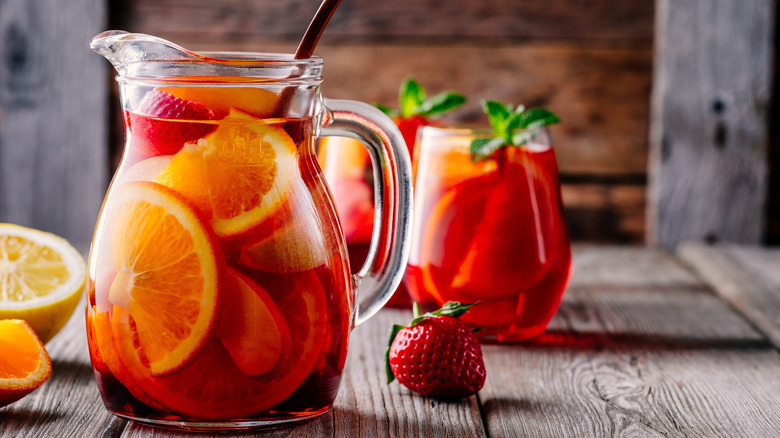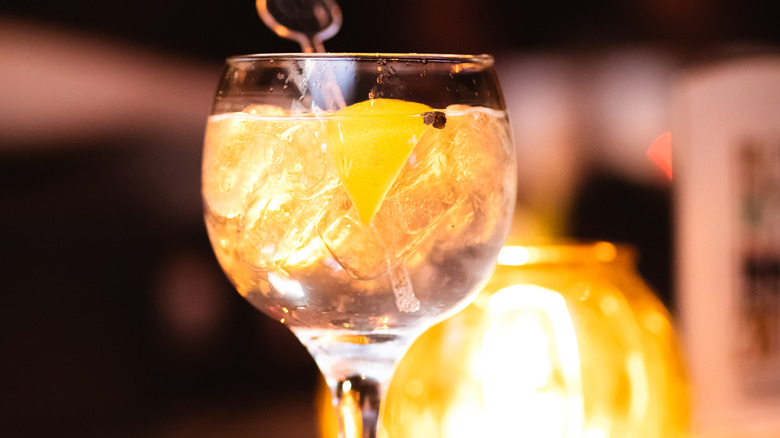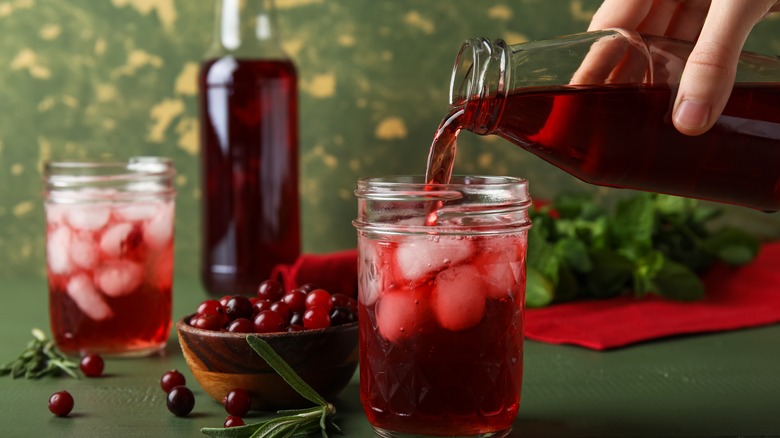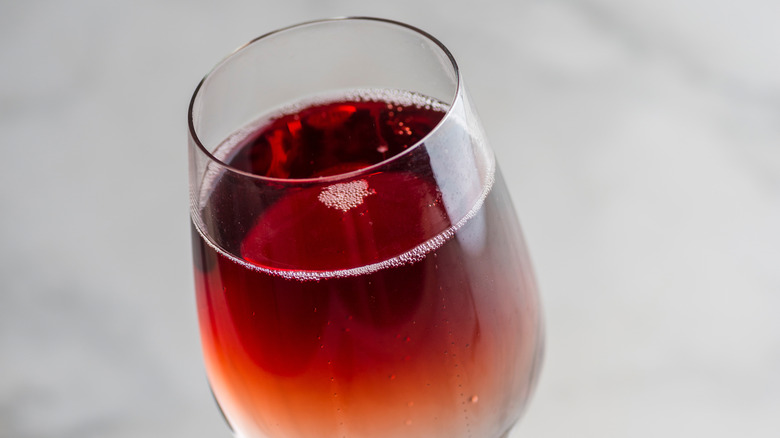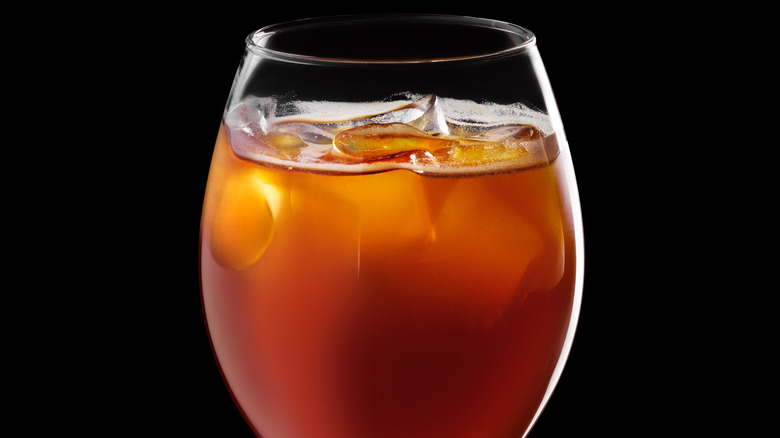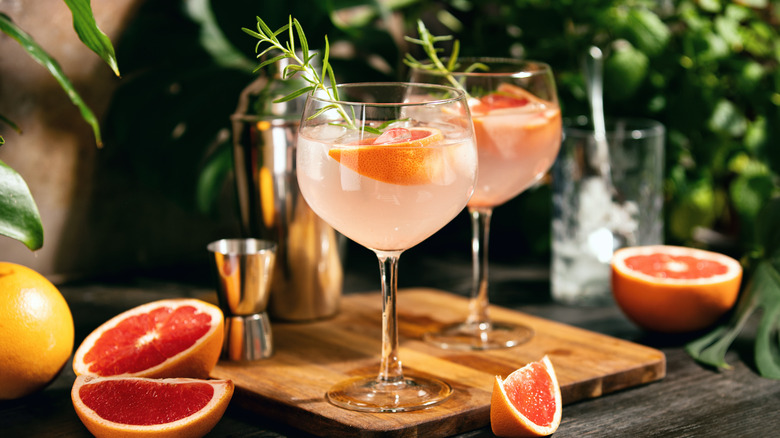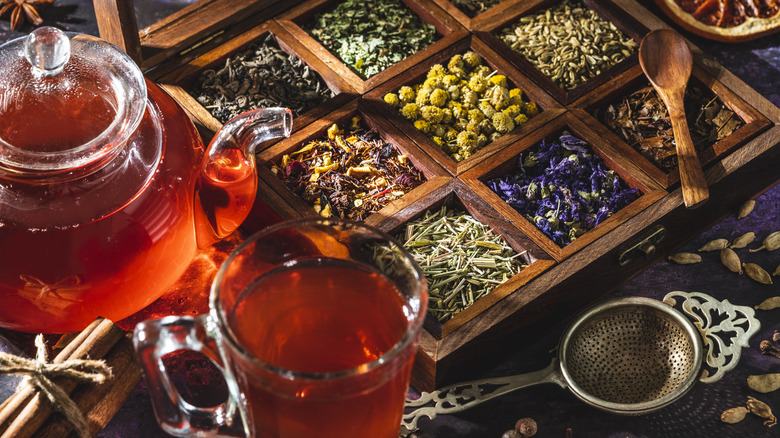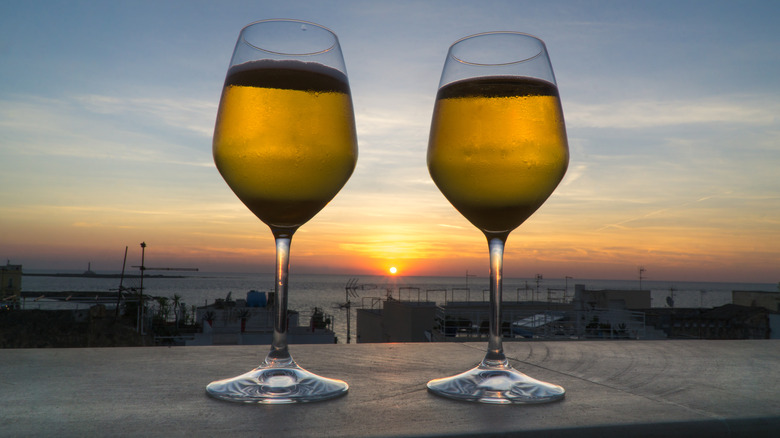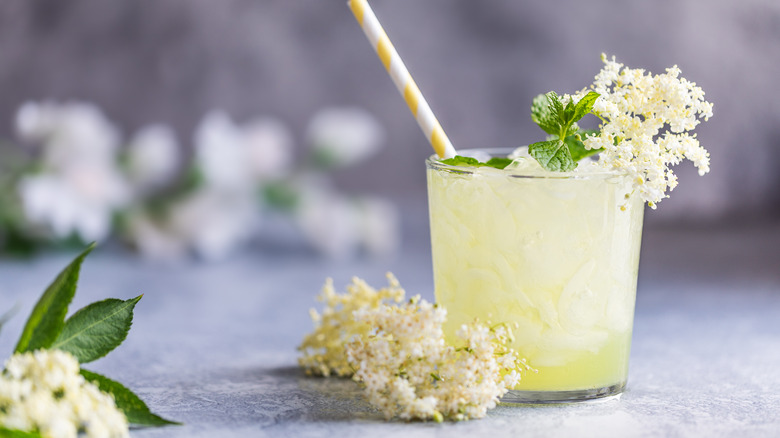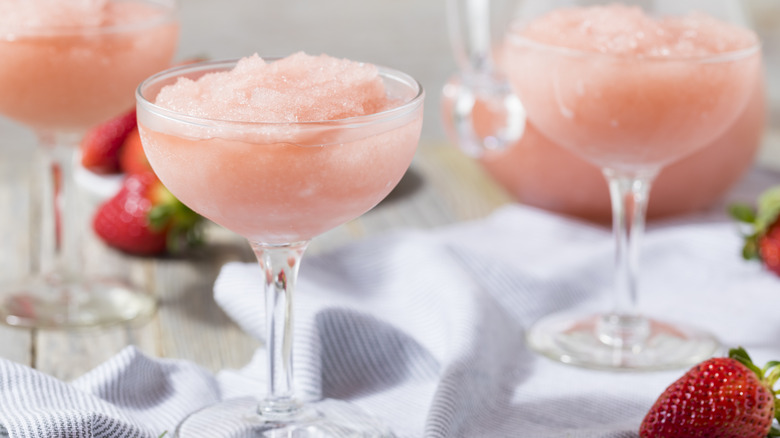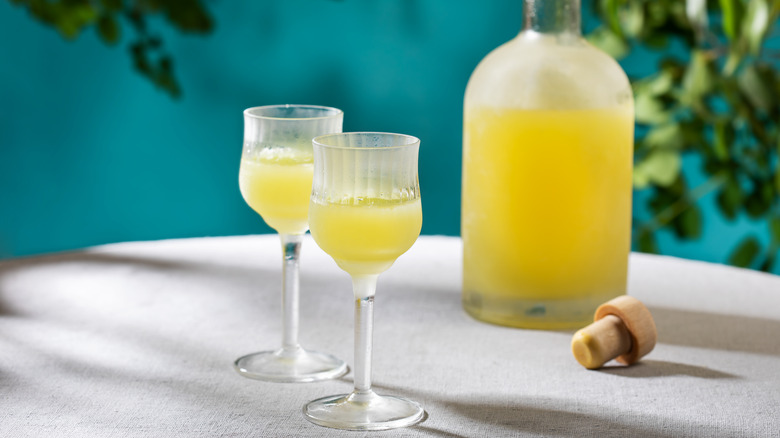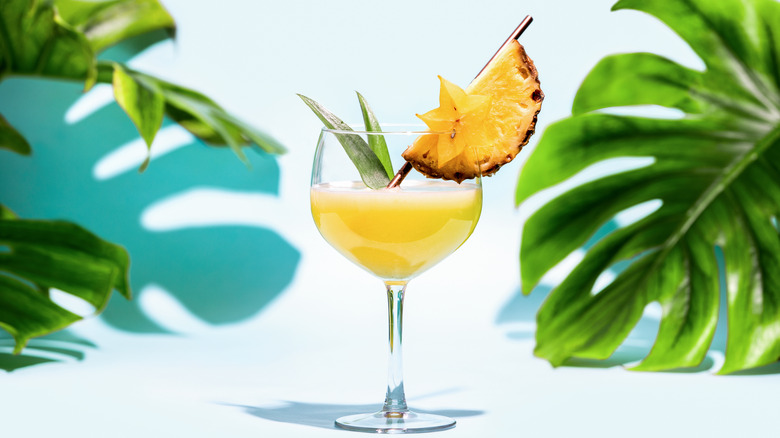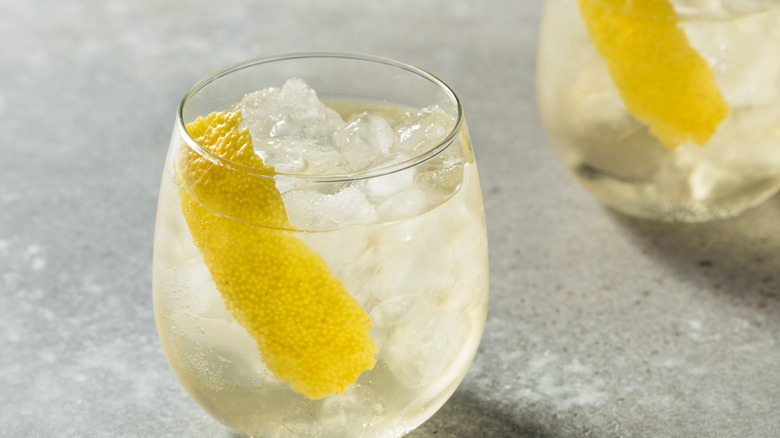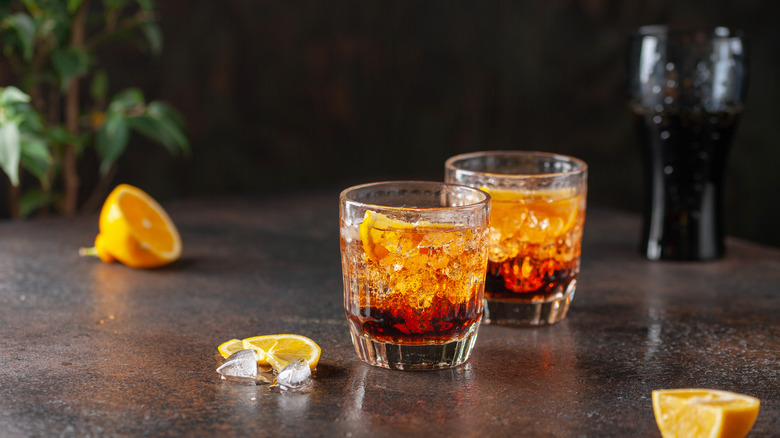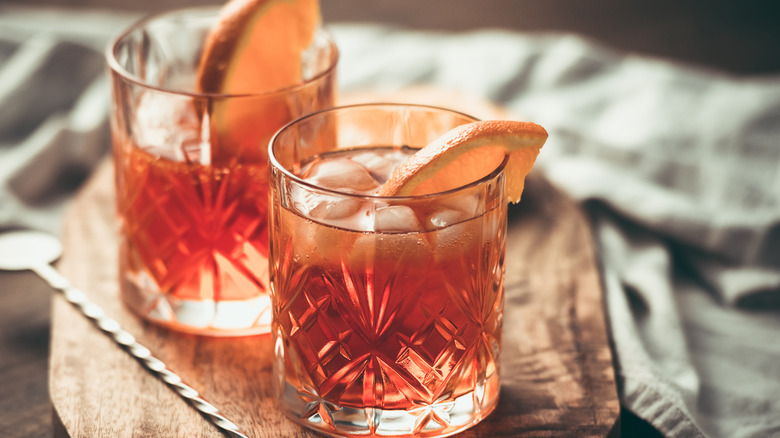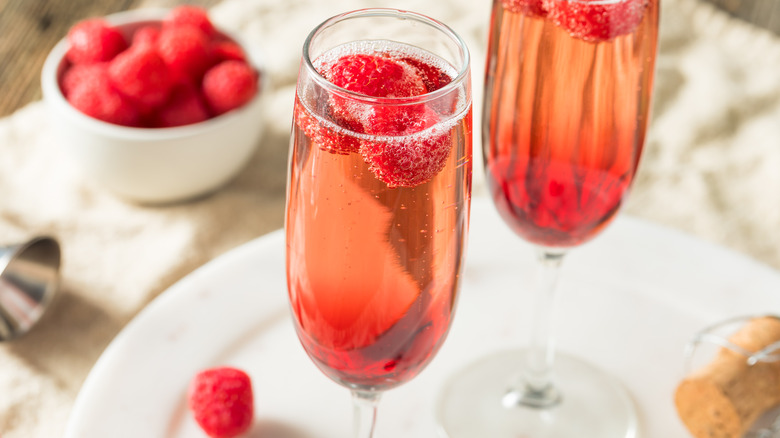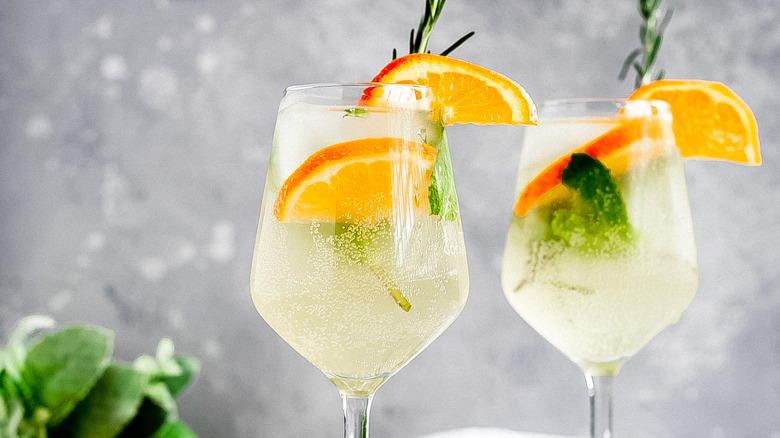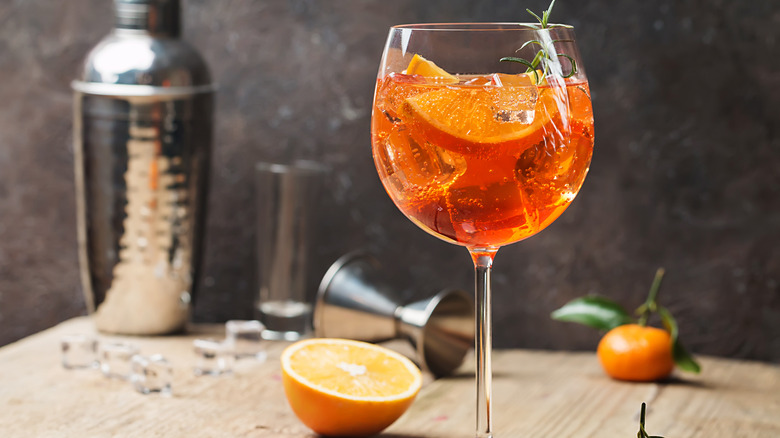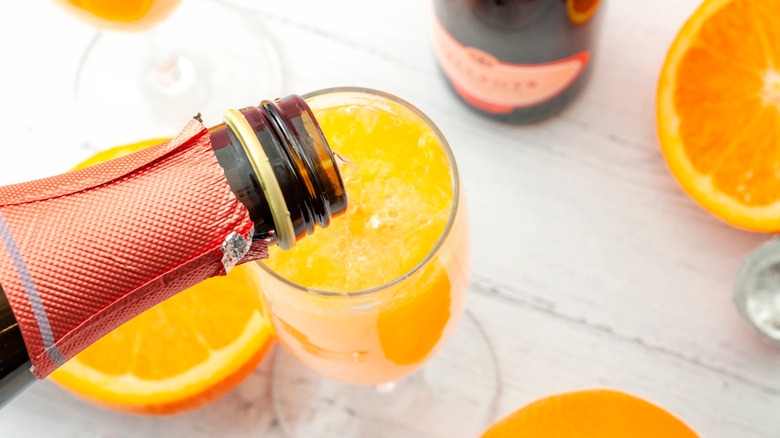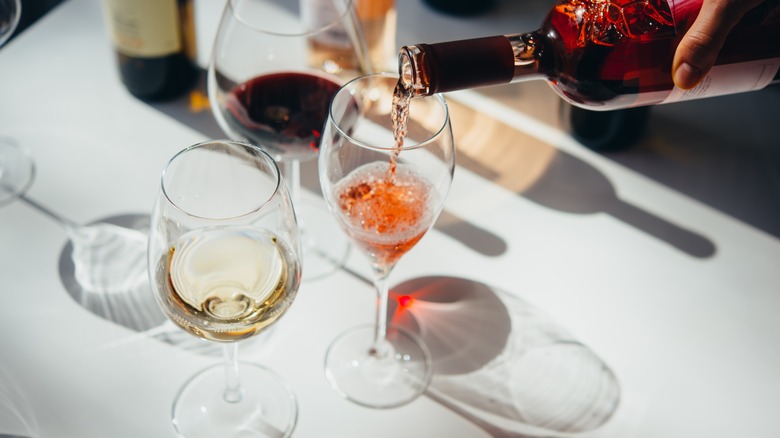20 Tasty Drinks To Mix With Wine, Ranked
When we think of pouring a glass of wine, we don't always consider adding anything to it (except for sometimes ice). After all, wine is pretty darn good on its own — something the vineyards and brands behind the bottles intend it to be. But there are times when you may need to switch things up, especially if you are not a big wine lover (or you have someone coming over who isn't the biggest fan).
We did some research and found a large range of different mixers to try with wine. Some are more traditional (like everyone's favorite brunch cocktail), while some are just downright different (who knew apples and grapes went together?).
There are dozens of drinks you can mix with wine. The goal is to ensure the resulting cocktail is balanced, with the mixer complementing the wine's natural flavor. Through tasting, research, recipe testing, and many years of experience drinking wine, we narrowed the list to the 20 best mixers to make that perfect wine cocktail, ranking them from worst to best.
20. Apple Juice
There are plenty of reasons why we love apple juice. All the health benefits, including decreased cardiovascular disease risk, according to a scientific review of the literature, and the delicious taste make apple juice stand out on its own. There's really no reason to do anything more to it — unless you're creating a cocktail. Apple juice has many pros, including the fact that it makes for a solid cocktail mixer (and not just with spirits, either).
Okay, we get that apple juice is not the first thing that comes to mind when making a wine-based drink, but hear us out. When you mix red wine and apple juice (and some fresh fruit), you can get a fruity concoction that resembles a sangria — only it's a whole lot easier to make. Try using sliced peaches and a medium-bodied red when you mix this baby up, and then serve it over ice.
19. Tonic Water
Tonic water has been a staple cocktail mixer for a long time. And who can argue? It's light, easy, and adaptable. It's made with sugar, soda water, and a compound called "quinine" that comes from the cinchona tree in South America, which gives tonic water that slightly bitter taste it is known for, unlike sparkling water or soda water alone.
While tonic water is widely mixed with spirits to make simple yet tasty cocktails, we also believe it can be used with wine. When you're craving something crisp and easy, all you need is some white wine, tonic water, and ice to make the perfect drink. Adding some summer fruits can help elevate this drink, which we think is perfect for when the temperatures start to rise. This is one of those drinks that is ideal for anyone who may not love wine but doesn't hate an easy spritzer on a humid day.
18. Cranberry Juice
The United States is the largest producer of cranberries in the world, and while they have a permanent place on our Thanksgiving table, most of us consume those tart red berries in the form of cranberry juice for the rest of the year. According to WebMD, the drink contains many vitamins and minerals, may improve your heart and stomach health, and may boost your immune system thanks to its rich vitamin C content.
Mixing cranberry juice and red wine in a zesty cocktail like a red sangria packs a one-two health punch, as both drinks are high in antioxidants. However, we find tart and tangy cranberry juice tastes better with dry sparkling wine. It is the zesty zing of acidity your Prosecco punch is begging for. We suggest using pure, unsweetened cranberry juice instead of a cranberry cocktail. The cranberry cocktail has added sugars, diluting the authentic flavor of pure juice while masking the sparkling wine's taste.
17. Sprite
Sprite has been around for a long time, dating back to its origins in Germany in 1959. At that time, it went by the name Clear Lemon Fanta and changed to Sprite once it hit the U.S. two years later. Its popularity grew in the '60s with a younger generation — and for good reason. Its crisp taste is a win with a mix of lemon and lime, and it naturally makes for a perfect mixer in a refreshing cocktail.
It's a soda we normally might use when whipping up a chilled white wine spritzer for an outdoor summertime party, but it can be paired with red wine, too. Simply mix red wine and Sprite over ice, and add some lemon and mint if you have them on hand. Stick with a fruity red wine, like a shiraz or a blend, so it's not too heavy, but rather light and refreshing.
16. Ginger Beer
Some people enjoy drinking ginger beer on its own, while others prefer to mix it in a cocktail. No matter your fancy, we get why ginger beer is so well-liked. Ginger beer has an intense ginger taste that is deeper than ginger ale, but it is still bubbly, keeping the drink light and tasty. It is also non-alcoholic unless you buy a specialty alcoholic version, and all of these attributes make for a great mixer.
Mixing ginger beer with wine might sound strange, but it works. It is also incredibly simple to do, as you don't need a lot of ingredients to make this drink come together. Opt for a light-bodied red wine like pinot noir and mix it with ginger beer and ice. Red wine and ginger beer make for a delicious summertime cocktail, especially when you add orange slices to the mix for a touch of citrus (an ideal refreshment after sitting in the summer sun).
15. Rum
One of the best uses for leftover wine is mixing it with rum for a classic Bishop cocktail. The drink mixes three parts of light rum (also called white rum) with one part of red wine, a splash of simple syrup, and a squeeze of lime.
The white rum is essential here as it has a natural sweetness from the sugar cane base, with subtle notes of vanilla and spice from the limited amount of barrel aging the rum undergoes. These characteristics will complement the fruit and spice notes of oak-barrel-aged red wine, adding depth and complexity. Using a more neutral flavored liquor, like vodka, will not impart the same richness into the cocktail.
It is also best to use a lower-tannin wine that does not have a lot of peppery spicinesses. A bold, tannic wine like tannat or shiraz will overpower the delicate notes of the liquor. Traditionally, pinot noir was the wine of choice for a Bishop cocktail. However, we tried the cocktail with a fruity grenache, resulting in a delicious, multi-layered drink. Merlot, mencia, and cabernet franc wines will also pair with the rum.
White wine and rum can also work well together, especially with the inclusion of other fruits. We recommend making a twist on a white wine sangria, adding rum instead of the brandy, triple sec, or any other liquor traditionally included, along with tropical fruits like pineapple and mango.
14. Grapefruit Juice
Like other juices on our list, grapefruit juice has many health benefits that make it a win-win to consume. Grapefruit juice is packed with antioxidants and nutrients that work to keep your immune system healthy and strong. And while grapefruits can be on the bitter side, which may not always be everyone's favorite, they can also be tart and crisp, which we think works well when making a mixed drink.
You may not have thought to pair this bitter and tart juice with wine, but we think it's worth a shot. Fresh grapefruit juice is best, but store-bought can be used in a pinch (just look for real grapefruit juice, not a concentrate). When mixing the two ingredients, reach for a prosecco as it has hints of peach and melon, which works nicely with the grapefruit flavors (and we think makes for a delicious drink). It also looks classy when served in a balloon glass with a slice of grapefruit as a garnish.
13. Tea
Tea and wine have similar qualities and characteristics. The production of both drinks comes from all-natural ingredients. Both have deep aromas and rich, complex flavors, and both have significant historical and cultural importance. Even the taste of both wine and tea is heavily influenced by its provenance, with the character telling the story of the terroir.
Like wine, tea can contain high amounts of tannins, which are high in antioxidants. Their effect lends a dry, astringency to drinks like wine and tea. They also impart a well-rounded, full-bodied mouthfeel, enhancing the overall flavor. Tannins in wine are present in the skin and seeds and are extracted from barrels when aging. Tannin in tea comes from allowing the leaves to break down and oxidize, lending color and texture. When mixing the two drinks, it is best to use either a low-tannin wine, such as an unoaked sauvignon blanc or pinot grigio, or a tea with low tannins. Oolong tea is low-tannin and highly flavorful, matching with light-bodied red or fuller-bodied white wines.
The best way to mix wine and tea is through an infusion, ideally using loose tea leaves, allowing them to steep in wine for a few hours in a cool, dry place out of the sunlight. Adding additional ingredients that complement both flavors, like herbs, spices, or citrus zest, is always an option, like infusing oolong tea with a light-bodied pinot noir and rose petals.
12. Ginger Ale
Ginger ale is another one of those tasty refreshments that is good on its own but perfect when added to something else (like a rye whiskey). The taste is refreshing and offers both a little burst of citrus and a hint of pepper, thanks to the actual ginger that's used to make it. That said, ginger ale's flavor is not as intense as ginger beer because it's more carbonated. The overall result is refreshing and makes one amazing spritzer.
While some people opt for something completely flavorless in their spritzer, like basic carbonated water, sweet and somewhat spicy ginger ale elevates your spritzer to new heights. Mix ginger ale with white wine, and you get a quick and easy delight in your mouth. The butteriness of chardonnay works well with the spiciness of ginger ale, and so does adding a slice of lime, which can help complement the ginger flavor.
11. Lemonade
When we think of summer, we can almost taste a glass of ice-cold lemonade. It's the perfect combination of tart and sweet, as though lemons have been freshly squeezed into your glass. And this drink has been around for as long as anyone can remember. Lemonade goes back to medieval Egypt when a Persian poet, apparently, first wrote about it. Flash forward to the 1870s when people in the U.S. were encouraged to drink lemonade as an alternative to anything with booze in it during what was called the "temperance movement."
These days, lemonade can be enjoyed in many ways, including with booze, as opposed to being a solely non-alcoholic beverage. We encourage you to get crafty with your cocktails and combine a crisp white wine with lemonade for a refreshing summertime sip. Using Italian sparkling lemonade and mint will take it a step further and help turn this easy cocktail into a wine mojito.
10. Sparkling Juice
We're all about bubbly sparkling juice, whether on its own or mixed with wine. It's made by fermenting the fruit juice, which creates natural carbonation and, you guessed it, the right amount of fizz — who wouldn't want to add sparkling juice to a cocktail? We're definitely on board, especially if we want to make a cold, refreshing frozé (aka frozen rosé). This popular summertime sip has been a huge hit for thirsty drinkers who love wine and who also really enjoy a sweet, adult-style slushy to sip.
You don't have to get too complicated when making one, either. When you mix your favorite sparkling fruit juice with a fruit-forward rosé wine, you can easily get a standout frozé. All you need to truly impress your guests is to add in some frozen fruit, like strawberries and cherries, for a super juicy kick, then blend it all up and enjoy.
9. Limoncello
The Italian liqueur limoncello uses either Femminello St. Teresa lemons or Sfusato Amalfitano lemons grown around Italy's Amalfi Coast and Capri. The fruit's skins are rich in natural oils that lend an intensely rich lemony flavor to the liqueur. Soaking the highly fragrant lemon peels with natural alcohol and sugar creates a sugary, sweet liquid bursting with tart citrus flavor. Mixing the liqueur with a dry white or sparkling wine will accentuate the fruity citrus notes while adding sweetness. Limoncello has a strong flavor, so only a dash is necessary to deliver its rich lemon flavor.
Create a refreshing limoncello spritz cocktail by adding one part limoncello to two parts Prosecco and topping with club soda. Or, for a cocktail that is as beautiful to look at as it is to drink, add limoncello to a high-acid white wine, like riesling or sauvignon blanc, and top it with club soda. Finish the drink with a splash of butterfly pea flower tea. The wine's acidity will cause the transforming flower to create a gorgeous purple-hued wine cocktail with vibrant floral and citrus aromas and flavors.
8. Pineapple Juice
Did you know how versatile pineapple juice can be? Not only can it be used to make a classic fruit smoothie, but you can use it in plenty of dishes as well, including as a marinade for your favorite grilled meat. Pineapple juice has some great health benefits, too, including being a good source of vitamin C, vitamin A, and beta-carotene, according to WebMD.
When it comes to cocktails, versatility may not be the first thing to come to mind, as everyone thinks they know what to do with pineapple juice: mix it with rum. Look, we like that, too, but sometimes we want to be a bit more playful with our fruity drinks. Try mixing pineapple juice with a glass of white wine for a different take on the more traditional rum cocktail. Stick with a sweeter white wine, such as a riesling, to have it taste like a refreshing glass of fruity sangria. Once you try it, you'll understand why we think it's one of the best drinks to mix with wine.
7. Club Soda
Club soda is carbonated and provides that fizzy kick we love in our refreshments (ahem, alcoholic beverages). It's also infused with a wide range of minerals, such as potassium and sodium chloride, which helps add a mild, salty flavor. Between the bubbles and the taste, club soda is a go-to when it comes to making cocktails. Okay, we probably didn't have to sell you too hard on mixing club soda in a cocktail, but what about using it with wine? Yeah, that's what we thought. But really, it's kind of a perfect combination.
Combining club soda with wine is a great drink for the warmer months because there's a touch of citrus that makes for an easy sip. It's also a quick drink to make when hosting a crowd. The key here is to use an aromatic white wine that stays on the palate even after the club soda is added, but whether you choose a sweet moscato or a dry sauvignon blanc is simply a matter of taste.
6. Coca-Cola
What do you get when you mix Coca-Cola with wine? Something seriously delicious. It's called kalimotxo and it's been a favorite in Spain since the 1920s. However, it didn't become big until the 1970s when the stigma of mixing wine with sugary soda wore off, and it was officially introduced at a festival in the Basque Country. Today, the drink is as popular as ever in Spain but has also gained quite a foothold in the United States.
We have to say, we kind of get it. You only need two ingredients (red wine and Coca-Cola), so it's super easy when you're in a pinch. Plus, it's an actual cocktail and not something you just made up that hopefully tastes good. We already know it does. The flavor combination is perfect as the caramel notes from the Coca-Cola help balance the tartness of the wine perfectly. Sure, you could use a different soda, but why mess with a classic?
5. Whiskey
Mixing whiskey and wine may not be the first combination to come to mind, but the two have more in common than you may think. Both are artisanal products crafted with care and often aged in oak barrels, creating a similar flavor profile.
Like mixing wine with tea, you will want to look for complementary characteristics to ensure proper balance in the drink. Lighter-bodied wines will pair best with lighter-bodied whiskey. A 4-year-old bottled-in-bond bourbon or 8-year-old single malt scotch will contain floral, fruit-forward notes of figs, citrus, white flowers, and honied caramel. These flavors will meld nicely with a citrus-forward sauvignon blanc or fruity prosecco. Older whiskey will have more spiciness, nuttiness, and toasty oak flavors, working well with dry, oak-aged red wines with earthy, spicy notes, like cabernet sauvignon or syrah.
Whiskey can also elevate many classic wine cocktails that traditionally use clear spirits. Using a blended scotch instead of gin in a traditional French 75 cocktail lends honey, vanilla, and orange zest to the cocktail in place of the botanical and floral notes gin provides, enhancing the toasty brioche and creamy lemon custard notes found in Champagne and giving more weight to the drink. Or elevate a whiskey sour into a New York Sour by adding a dry red wine floater, bringing a dash of fruitiness to the sweet and sour cocktail.
4. Crème de cassis
Crème de cassis is a liqueur from Burgundy that is over 150 years old and is known for its ultra-sweet flavor (thanks to being made with black currants). Those berries also provide a zip of tartness that keeps things well-rounded. While it's a great addition to several types of cocktails made with spirits, it should be used sparingly, as it can turn a slightly sweet cocktail into something way too sugary.
One of the most well-known cocktails made with crème de cassis is the Kir Royale, which is a favorite French aperitif. There's a reason why it's the favored sip before dinner, as it's bubbly, light, and won't fill you up before a big meal. It's also a super simple drink to master, with just sparkling wine (Champagne if you're fancy) and crème de cassis, but it appears incredibly fancy and complicated. Stick with a dry sparkling wine so it isn't too sweet, and top it off with fresh raspberries.
3. Elderflower Liqueur
Chances are, if you have gone to a swanky cocktail bar known for its handcrafted concoctions, you have had a drink or two made with elderflower liqueur like St-Germain. This type of liqueur comes from the flowers of an elderflower bush and typically does not have any preservatives, which means its shelf life may not be as long as others. While that could be a problem if you only use it on occasion, we think once you start using it in your cocktails, you will not be waiting for months to use it again. The overall flavor profile of elderflower liqueur is similar to a combination of peach and pear, making it ideal for crafting mixed drinks.
Since this liqueur has a tasty profile of its own, you do not have to go overboard when adding additional ingredients to the mix. Try adding a dry sparkling wine, which will make for both an easy and elegant sip.
2. Aperol
Aperol is a classic Italian liqueur that has been around since 1919, and it first gained popularity with the younger crowd who frequented trendy Italian cafes. Later on in the 2000s, the Aperol spritz cocktail saw a resurgence and became a mega-hit all over the globe, and it continues to be a popular choice among many today. The reason for this is simple: It's good — really good. Also, like so many others on the list, it's easy to make.
The quickest way to master one of these well-liked and iconic cocktails is to combine Aperol and prosecco. If prosecco isn't your favorite, any inexpensive sparkling wine will surely do, while adding a splash of club soda can help dilute too much fizz if that's not your thing. While you don't need a fresh orange slice for the garnish, we think it's worth an extra trip to the store when you really want to impress your guests (and yourself).
1. Orange Juice
We have to admit that we do love our orange juice. It quenches our thirst and goes great with eggs, but it is also a healthy choice that is loaded with cell-repairing vitamin C and folate needed for proper development during pregnancy, according to Healthline. Needless to say, we feel pretty darn good about drinking it. While all of these reasons are enough to enjoy a simple glass of OJ, it's even more iconic when served at brunch with a favored mix-in — some bubbly, of course.
Orange juice is hands down one of the best drinks to mix with wine, and we think you'll probably agree (if you don't already). It's everyone's favorite brunch cocktail and incredibly easy to make. When looking for the right wine, shoot for a prosecco or a sparkling wine that is on the dryer side rather than using anything too sweet. The orange juice is all the sweetness you need. Whether you top your orange juice with a small bit of bubbly or top off your glass of bubbly with the smallest bit of orange juice for a little color and flavor, the pair is an undeniable winner.
Methodology
The two writers who contributed to this ranking have many years of combined experience in food writing and wine drinking. Carissa Chesanek is a food writer and former Food Network digital producer and Hayley Hamilton Cogill is a long-time wine lover and home mixologist who has spent years taste-testing various drinks with wine, finding flavors that will complement and enhance her nightly glass.
Our wine experts selected these drinks based on value, specific types and brands that are widely available, and complementary flavors for the specific tasting profile of the red, white, or rosé varietals and blends.
Static Media owns Tasting Table and Mashed.
